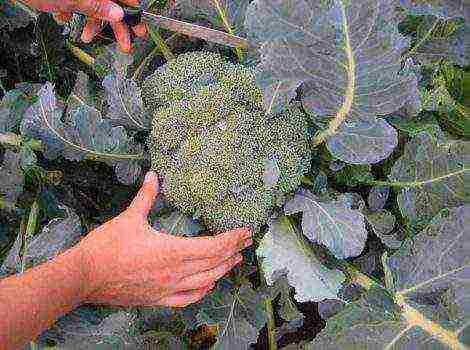Content
- 1 Bratchud
- 2 Carpet
- 3 Legend
- 4 Moscow red
- 5 Stunted
- 6 Snowdrop
- 7 Grounded
- 8 Early sweet
- 9 Sokolovskoe
- 10 Sun
- 11 Wonderful
- 12 How dwarf apple trees differ from the rest
- 13 Are dwarf and columnar apple trees the same thing?
- 14 Features of growing dwarf apple trees
- 15 Overview of common dwarf apple varieties
- 16 Semi-dwarf apple varieties
- 17 Breeding novelties
- 18 Gardeners reviews
- 19 What varieties of dwarf apple trees are best to choose for your summer cottage garden?
- 20 general characteristics
- 21 Dwarf apple varieties
- 22 Useful photos and videos
- 23 Conclusion
Low-growing apple trees attract gardeners with their compactness, high yield and resistance to diseases. And if the size of the site is small, then there is no better option for organizing a mini-garden.
Usually, an apple tree is represented as a tall and mighty tree with a spreading crown, which casts a shadow over almost half of the site. However, an apple tree reaches this size by the age of 15-20, and even then not always. Even within the same variety, an apple tree can grow, or it can remain a dwarf tree. It turns out that the "growth" of a tree depends on rootstock... It acts as the foundation of the future apple tree, its choice affects the duration of the productive period of the tree, the timing of its entry into the fruiting and ripening phases, the taste, appearance and size of the fruits, as well as the duration of their storage.
An apple cultivar can be grafted onto a vigorous or dwarf stock. Depending on this, the tree will also be either tall, with a massive crown, or stunted, supported by a trellis. However, there are varieties that are natural "dwarfs", i. E. even on an ordinary rootstock, their height does not exceed 3 m. Some of the most popular are the following varieties of dwarf apple trees.
Bratchud
The full name of this winter variety sounds like "Brother of the Wonderful", it is suitable for cultivation in all climatic zones. The tree is a natural "dwarf" with a flat-rounded crown up to 3 m in diameter. Fruit size usually does not exceed average values. Their distinguishing feature is the presence of a small seam in the form of a strip. The skin is dry, with a glossy sheen. The main color of the fruit is greenish-yellow, later a crimson blush appears. The pulp of ripe fruits is white, coarse-grained. It cannot be called juicy, but the taste remains pleasant. The variety is high-yielding, transportable, with a long shelf life.
| Entering fruiting | Tree height (m) | Fruit weight (g) | Harvest | Shelf life (days) | |
|
3-4 years |
1,5-2 |
140-160 |
End of September |
120-140 | |
Carpet
Autumn variety of apples. The crown of the tree is horizontal, drooping. The size of the fruits exceeds the average size and can reach 200 g. The fruits are flat-rounded, their main color is greenish-yellow, subsequently saturated with a red blush. The pulp is creamy, coarse-grained and slightly juicy, moderately aromatic, with a pleasant sweet and sour taste.The variety has a stable high yield. During a long winter, the lower branches can break off under the weight of the snow.
| Entering fruiting | Tree height (m) | Fruit weight (g) | Harvest | Shelf life (days) | |
|
3-4 years |
1,5-2 |
150-170 |
End of September - beginning of October |
50-60 | |
Legend
Early winter grade. A tree with a dense spherical crown and compactly spaced shoots. Fruits are slightly ribbed, grow rather large, resemble a truncated cone in shape. The main color of apples is greenish with a yellow tint; as they ripen, the fruits turn red. Occasionally, burgundy stripes appear on their surface. The pulp is white, creamy, juicy, fine-grained with a strong aroma. The taste of the fruit is sweet, caramel. The advantages of the variety are frost resistance and immunity to most pests and diseases.
| Entering fruiting | Tree height (m) | Fruit weight (g) | Harvest | Shelf life (days) | |
|
2-3 years |
2-3 |
180-200 |
Early October |
60-90 | |
Moscow red
High-yielding winter variety. The tree is not tall with a compact spherical crown. Fruits are round in shape, without ribs. The main color of the fruit is greenish-yellow; as it ripens, it acquires a bright yellow tint. By the time the fruit is picked, a deep red blush appears on the surface. The pulp is yellowish, with a pleasant sweet and sour taste. The variety is resistant to scab and other diseases, fruits and leaves remain healthy throughout the entire ripening period.
| Entering fruiting | Tree height (m) | Fruit weight (g) | Harvest | Shelf life (days) | |
|
For 6-7 years |
2-3 |
130-190 |
End of September - beginning of October |
90-120 | |
Stunted
Trees are undersized, branches grow at right angles to the trunk. Fruits are medium in size, round in shape, with large, well-visible ribs. The color of the fruits is greenish-yellow; as they ripen, red stripes appear on their surface, merging into a solid blush. The pulp is greenish, dense, fine-grained, juicy, with a sour-sweet aftertaste. The variety is winter-hardy, fast-growing, high-yielding. However, in a rainy summer, the leaves are affected by scab.
| Entering fruiting | Tree height (m) | Fruit weight (g) | Harvest | Shelf life (days) | |
|
3-4 years |
1,5-2 |
130-150 |
Second half of September |
120-150 | |
Snowdrop
Shale apple tree with predominantly horizontal branches. Young trees bear fruit almost every year. The fruits are medium in size, although there are specimens weighing 300 g. Their shape is rounded-conical with small ribs. The main color of the fruits is light yellow, later they are covered with a dark red blush. The pulp is light white, very juicy and tasty. The fruits are consumed both fresh and used for making jams, preserves and compotes. The consumption and removable ripeness of apples coincide, so they can be consumed immediately after picking.
| Entering fruiting | Tree height (m) | Fruit weight (g) | Harvest | Shelf life (days) | |
|
3-4 years |
1,5-2 |
140-170 |
Beginning of September |
100-120 | |
Grounded
During the growth period, the branches of the tree begin to grow horizontally, almost parallel to the ground, while their ends are bent upward. Fruits are regular and round in shape, their size is slightly less than average. The main color of the apple is greenish-yellow; as it ripens, a red blush appears, which occupies the entire area of the apple. The pulp is greenish, firm, very juicy and rich. The fruit tastes sweet and sour, suitable for making jams and preserves. The tree can withstand frosts down to -40 ° C, and bears fruit annually.
| Entering fruiting | Tree height (m) | Fruit weight (g) | Harvest | Shelf life (days) | |
|
2-3 years |
1,5-2 |
90-110 |
September |
50-60 | |
Early sweet
Low-growing tree with a flat-rounded crown. Bears fruit annually. Fruits are flat-round and medium in size. The main color is light yellow. The pulp is white and sweet, with a slight creamy shade. Winter hardiness and scab resistance are very high.
| Entering fruiting | Tree height (m) | Fruit weight (g) | Harvest | Shelf life (days) | |
|
3-4 years |
1,5-2 |
90-100 |
Early august |
10-15 | |
Sokolovskoe
Winter variety, bred relatively recently. Fruits are larger than medium in size, flat-rounded. The shiny skin is usually greenish-yellow in color; as it ripens, the apple turns into an expressive dark red blush. The pulp is creamy, dense and juicy, fine-grained. The taste of the fruit is sweet and sour with a pleasant aftertaste. They are consumed fresh and used to make jams, preserves and compote. The Sokolovskoe variety is a natural "dwarf" with high productivity, but insufficient resistance to summer heat and frost.
| Entering fruiting | Tree height (m) | Fruit weight (g) | Harvest | Shelf life (days) | |
|
3-4 years |
1-1,5 |
170-190 |
October |
100-110 | |
Sun
A late autumn variety with immunity to scab, bred over 20 years ago. The crown is round, not very thickened. Fruits grow within medium size, oblong-beveled shape, smooth and oily skin. The main color of the fruits is greenish-yellow, as they ripen, they turn yellow, and a raspberry blush appears on them. The pulp is white, with rare creamy splashes, juicy and dense. Apples have a sweet and sour taste with a rich aftertaste. Winter hardiness and productivity of the variety are high.
| Entering fruiting | Tree height (m) | Fruit weight (g) | Harvest | Shelf life (days) | |
|
3-4 years |
1,5-2 |
140-160 |
Second half of September |
90-120 | |
Wonderful
The tree is undersized (natural "dwarf"), the crown is formed in a horizontal plane, almost creeping along the ground. The fruits are large, more than average in size, the weight of some reaches 200 g. The shape of the apples is flat-rounded, the main color is yellow-green, as it ripens, a rich bright red blush appears. The pulp of the fruit is juicy, with a fine-grained structure, sour-sweet taste, with a pleasant aftertaste. The variety is characterized by increased winter hardiness and scab resistance.
| Entering fruiting | Tree height (m) | Fruit weight (g) | Harvest | Shelf life (days) | |
|
2-3 years |
1,5-2 |
120-140 |
Early august |
25-30 | |
How dwarf apple trees differ from the rest
The differences between tall and dwarf trees become noticeable even at the stage of choosing a particular seedling. When buying, dwarf seedlings can be distinguished by their appearance. For example, along large buds at the ends of branches or a fibrous root system with small roots. Tall apple trees, by comparison, have a rod-shaped root system.
The roots of dwarf apple trees are shallow, so such trees can be planted in areas with a groundwater level above 1-1.5 m.
In the garden, dwarf apple trees are always easy to distinguish by their compact size, neat crown and regular fruiting. These trees reach a height of 2-3 m and begin to produce crops already in the third year.
Are dwarf and columnar apple trees the same thing?
Columnar apple trees are often confused with dwarf ones. However, these are two different forms of fruit trees. Dwarf apple trees are short trees with a spreading crown that can reach a diameter of 3 m. Columnar apple trees have a well-defined trunk with short lateral branches. In shape, it resembles a column, in the upper part and along which fruits grow. In order not to be mistaken when choosing a seedling, pay attention to the following signs:
- a columnar apple tree grows in one trunk, practically without lateral branches;
- the root system of a dwarf apple tree is fibrous (in a columnar one it is pivotal), the more elastic it is, the healthier the tree.
Dwarf apple varieties are intended for small areas with a close location of groundwater. They take up little space, quickly bear fruit and give a bountiful harvest. The fruits of low-growing apple trees are stored for a rather long time, have a marketable appearance and have a pleasant taste and aroma. Be sure to plant them in your garden to appreciate all the benefits of plants.
Ripe juicy apples picked from your garden are much tastier than those bought at the market or in the supermarket. After growing apple trees, the gardener puts his heart and soul into this difficult business. But quite often it happens that the varieties that we loved from neighbors or friends are not suitable for planting on our site. Most often, this is due to the small area of free land. Every year, breeders develop new varieties so that we can make our wishes and dreams come true. In small areas, you can plant dwarf apple trees, which are not inferior in quality to their tall counterparts.
Features of growing dwarf apple trees
The process of planting and caring for mini versions of fruit trees differs little from other species. But some nuances still exist. For example, it is unlikely that it will be possible to withdraw a dwarf variety from the usual one on your own. If we are planting an apple tree for the first time in our life, we should not suffer with vaccinations and reproduction, it is better to purchase seedlings in horticultural centers or at the poultry market.
Are apple trees different from different rootstocks
What is a dwarf rootstock? Why are varieties with the same name considered dwarf, semi-dwarf or medium-sized? Let's try to deal with these questions that arise for any novice gardener.
To get a new apple tree, a seedling must be grafted. A branch of a certain type that needs to be grafted onto a tree is a scion. The place to which the cutting is transferred is the stock. Allocate:
- clonal stock (growing in a vegetative way);
- seed (an apple tree is grown from a seed).
Thus, the same variety can be bred on a dwarf rootstock, and on any other. When grown, for example, on seed, the same varieties Melba, Golden Delicious, Kovalenkovskoe and others have the characteristics of tall or medium-sized apple trees. They, grafted onto a dwarf tree, acquire the qualities of dwarf trees.
Breeders are constantly working to create "real dwarfs" that do not require grafting.
Important! When buying seedlings, you need to ask the seller on which rootstock the variety was grown.
How to choose a seedling
The tree must be healthy, with a well-developed root system. When buying, we inspect the roots for damage. The twigs should not be dry. Vaccination is required. If there is no vaccination, then we are dealing with a wild apple tree. But there are other points by which you can distinguish the variety from the wild:
- The grafting site is traditionally located between the stem and the root collar. It has the shape of a small protrusion.
- The developed branches in a varietal grafted plant should be at least four.
- The 0.5 meter stem also indicates that we are purchasing not a wild, but a varietal apple tree.
- A grafted dwarf seedling has many small and flexible roots, it does not have a taproot, unlike a wildflower.
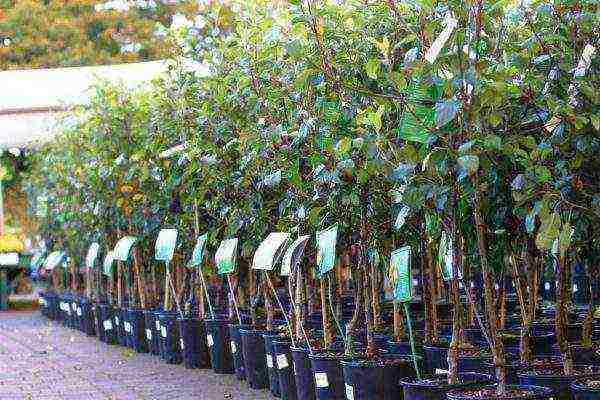
Varietal apple trees can be distinguished from wild ones by the presence of grafting and the number of developed branches.
Planting and caring for trees in spring
Dwarf apple trees, like ordinary ones, are planted in open ground in autumn and spring. Planting is carried out during the period of "hibernation" of plants, when the earth has already warmed up a little, but the tree buds have not yet blossomed. Gardeners are advised to prepare holes for seedlings in the fall, so that fertilizers are absorbed into the soil and the soil is compacted. If it was not possible to prepare the place in advance, we proceed as follows:
- We dig a hole 60–70 cm deep. Its diameter should be at least 60 cm.
- We stick a wooden stake into the landing pit.
- Add fertile soil to the hole.
- We pour in 0.5 kg of ash, a bucket of humus and 0.5 kg of superphosphate. Mix with the soil.
- Cover with fertile soil. The layer thickness should be 2–3 cm so that the roots of the apple tree do not touch the fertilizer.
- We lower the seedling into the hole, straighten the roots.
- The inoculation should be above the ground at a height of 3-4 cm.
- We compact the soil after planting the apple trees.
- Pour 2-3 buckets of water under each tree.
- We mulch the soil with humus.
Caring for dwarf trees is easy:
- The root system is located in the upper layers of the soil, so we make sure that the soil does not crack, does not dry out. After watering, we loosen the ground no deeper than 5 cm.
- At the beginning of spring, we whitewash the trees with lime.
- Once every 2 weeks we feed with complex fertilizers: Azofosky, Ekofosky or any others.
- In the spring, apple trees also need nitrogen and phosphorus fertilization. You can use wood ash, urea, nitrophosphate. We apply fertilizers according to the instructions on the package.
Video: planting a dwarf apple tree on an M-9 rootstock
Mandatory procedures in summer and autumn
Care in the hot season consists in loosening the soil and watering. It is important to ensure that the soil does not dry out or crack. As for the planting of dwarf apple trees in the autumn, it is similar to the spring one. In the fall, you need to carry out the following procedures:
- Cut off old and overlapping branches from the tree.
- We loosen the soil so that the pests cannot overwinter at the roots.
- As a preventive measure, we spray the apple trees with Bordeaux liquid (1%).
- For the winter, we cover the soil around the tree with a thick layer of humus so that the apple trees do not freeze out during the snowless period.
Video: we form a dwarf crown
Top dressing of apple trees
In spring, many plants lack nitrogen and phosphorus. Dwarf apple trees are no exception. We can use mineral complex fertilizers containing the necessary substances, including potassium.
Action plan:
- Dissolve fertilizers in 10 liters of water according to the instructions on the package.
- We make small pits in the soil, as if pushing the layers of the earth with a shovel. We pour fertilizers into them.
- Then cover the trunk circle with mulch. You can use processed peat mixed with humus, sawdust, compost.
We carry out top dressing according to the plan:
- In the spring, after the soil has warmed up.
- During the flowering period. We use organic fertilizers: peat, compost, chicken droppings.
- While pouring the fruit. For one adult apple tree we take a mullein (3 kg) and warm water (30 l).
- After harvest. We need nitrophoska (150 g) and warm water (30 l).
Video: features of spring feeding
Overview of common dwarf apple varieties
The main difference is the crown diameter is no more than three meters. Quite often they are confused with columnar varieties.
When buying seedlings, it is really easy to get confused. For example, Melba, grafted onto a dwarf stock, is very similar to a columnar apple tree up to three years old. In adult columnar trees, the crown consists of one trunk on which the fruits grow. Dwarf apple trees have a branched crown.
It is quite easy to distinguish seedlings in the market or in the garden center: in a dwarf apple tree, the trunk and roots branch out. The columnar has no branching on the trunk, and the root has the shape of a rod.
The best dwarf apple varieties
The generally accepted classification is according to the period of fruit ripening. Allocate:
- Early varieties (fruits ripen in summer). This is:
- Candy;
- Early sweet;
- Melba;
- Golden Delicious.
- Mid-season varieties (ripen in early autumn):
- Sun;
- Sokolovskoe;
- Grounded.
- Late ripening (harvest is harvested before winter) include:
- Bogatyr;
- Carpet;
- Snowdrops.
Dwarf varieties are classified according to cold resistance, taste:
- sour;
- sweet;
- dessert.
Table: popular varieties for the Moscow region and Central Russia
Photo gallery: dwarf apples of universal varieties
The fruits of the Grushevka of the Moscow Region are small, yellow with red stripes and spots, the taste is sweet and sour. Apples of the Arbat variety are of a beautiful wine color "with frost", very juicy and aromatic, sweet, there is a piquant acidity. juicy, dessert (sweet) Melba apples have a wonderful lollipop smell and have a sweet and sour taste,you can eat it just like that or use it in cooking. The Bogatyr's fruits are really heroic, especially for such a small tree, the taste is sweet and sour, the aroma is dizzying. Shtrifel, Streifling) are valued for their dense juicy pulp and sweet spicy taste Apples of the Belarusian Sweet will definitely be appreciated by lovers of sweet fruits: the taste is clean, without sourness and astringency, honey notes are noted
The best varieties for Belarus
Gardeners of Belarus prefer to choose cold-resistant and high-yielding varieties for their plots, such as:
- Kovalenkovskoe. The variety is frost-resistant, mid-season, and has a high yield. Fruits are dark green, have a red blush on the sides, weight up to 170 g. Apples tolerate transportation well.
- Belarusian sweet is considered a semi-dwarf variety. By the age of eight, the tree reaches a height of 3–3.5 m. High-yielding, frost-resistant - easily tolerates temperatures as low as -36 degrees. Up to 35 kg of apples can be harvested from a three-year tree. The average fruit weight is 160-170 g, the color is greenish-yellow.
- Darunok. This is a variety of Belarusian selection, reaching a height of four meters. Late ripening and frost-resistant, it easily tolerates temperature extremes and spring frosts. High-yielding: more than 35 tons of apples are harvested from 1 hectare. Fruits are green and wine-colored, with a high sugar content (9%), juicy. The skin is thin, elastic. Darunok is resistant to diseases, including scab.
- Memory of Syubarova. A late ripening variety, frost-resistant, high-yielding: more than 20 tons of apples are harvested from 1 hectare. Fruits are light green with a reddish blush. Average weight 130–140 g. Juicy pulp, sweet and sour taste. The variety is scab resistant.
Photo gallery: Belarusian apple trees
Dwarf apple varieties for the Urals and Siberia
Every year the number of varieties is growing inexorably, and it becomes more and more difficult to decide on the choice for your personal plot. In the Urals and Siberia, gardeners are trying to grow tall apple trees. They have a more powerful root system, they are resistant to severe frosts. But there are several varieties that have been adopted by local gardeners. These are Melba, Bogatyr, Moscow necklace, Silver hoof, Land and Snowdrop.
- Snowdrop variety. Trees grow up to two meters, winter-hardy. Apples are intended for long-term storage. They are kept in cellars and basements for up to four months. Medium-sized fruit with a high sugar content (9.2%), yellow in color with a reddish blush. The snowdrop begins to bear fruit at the age of three. The cultivar requires pollinators. The best for him are the Land and Carpet. A distinctive feature is a high yield: up to 80 kg of apples can be harvested from one bush. The variety is zoned for the Urals and Western Siberia.
- Grounded. Bred in the South Urals. The maximum height of the tree is 2.5 m. Winter-hardy variety. Often exposed to scab. The ground plant begins to bear fruit two years after inoculation, it has a high yield: up to 130 kg of apples can be harvested from one tree. The fruits are greenish-yellow with a deep red blush. The flesh of these sweet and sour apples is juicy, with a slight greenish tint. One of the best pollinators for this variety is Carpet. The variety is zoned for the Urals.
- Carpet. This apple tree grows to only two meters. Winter-hardy variety, zoned for the Urals and Siberia. Begins to bear fruit three years after vaccination. The yield is high: up to 60 kg of fruit can be harvested from one apple tree. Scab resistant. The best pollinators are Snowdrop and Earthy.
- Silver hoof. The variety was bred by the Ural breeder L.A. Kotov, named after the fairy tale of the same name by the writer P.P. Bazhova.Zoned in 1988 for the Urals and Western Siberia. Currently it is grown in the north of our country and Kazakhstan. Trees reach a height of three to four meters. It is a frost-resistant, self-fertile variety that needs pollination. The weight of one fruit is usually 80–90 g. Apples are rich cream color, with a red or orange blush on the side. The pulp is juicy, sweet and sour taste, creamy. The harvest begins in mid-August.
Interestingly, varieties zoned for the Urals and Siberia, such as Snowdrop and Prizemlenoe, are popular in Ukraine. Gardeners value them primarily for their frost resistance. After all, the temperature here can drop to -30–38 degrees.
Video: dwarf apple trees for the gardens of the Urals
Semi-dwarf apple varieties
In addition to dwarf trees, there are also semi-dwarf apple trees. What is the difference between these varieties? Apple trees, grafted on a semi-dwarf stock, below the dwarfs, are resistant to various diseases. Their height reaches only two to three meters. These trees begin to bear fruit in the second year after grafting. The apples are large, juicy and sweet. The best semi-dwarf apple trees include:
- Imrus. The variety is mid-season, frost-resistant, high-yielding. The fruits are large, sweet and sour. The crop is harvested from mid-September. This tree is also called the "unkillable Russian apple" due to its high immunity to powdery mildew and scab. Zoned for the Central Chernozem and Central regions of Russia.

Apples of the Imrus variety are large, yellow in color with a reddish blush
- Lobo. The variety is medium late, the fruits are harvested at the end of October. The apples are sweet and sour, juicy, raspberry-purple in color, covered with a dense waxy coating. Fruit weight varies from 100 to 180 g. The variety perfectly tolerates transportation, zoned for the Central Black Earth Region of Russia.
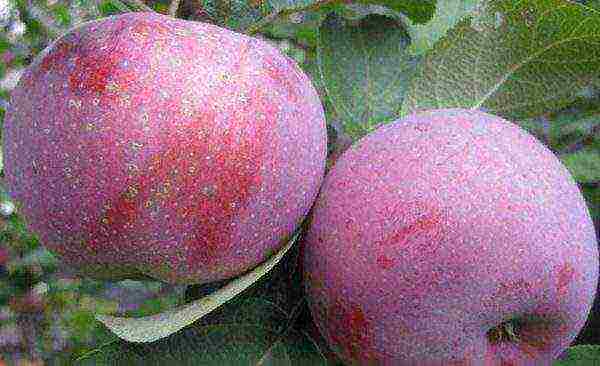
Lobo apples are easily recognizable by their rich crimson color with "rime" (wax bloom)
- Antonovka is ordinary. A high-yielding variety of late ripening, characterized by increased frost resistance. Grows well near groundwater. Fruits weigh from 100 to 125 g. The pulp is dense and juicy, the taste is sweet and sour. More than 20 varieties of apple trees have been created on the basis of Antonovka.

Antonovka is loved in Russia and the CIS: the sweet and sour taste of these yellowish green apples reminds of childhood, because in the past this variety was very popular in the USSR.
Breeding novelties
Recently, breeders have been working tirelessly to create new fruit trees. They do not need to be grafted onto a dwarf stock, they are natural dwarfs, more compact than their predecessors. The fruits of natural low-growing apple trees are large in size. The creation of new varieties takes time, but breeders can already please us with the following options:
- Moscow necklace;
- Autumn striped;
- Grounded;
- Carpet;
- Snowdrop.
Some of these varieties are zoned, others can be grown on the territory of Russia, Belarus, Ukraine and in other regions.
Gardeners reviews
The creation of full-fledged dwarf apple trees has been worrying breeders for a long time. The main goal of the experiments is still the formation of a miniature tree with large fruits and high yields. Perhaps, in the near future, breeders will be able to develop a variety that will become ideal for most gardeners.
Photographer, copywriter. Work experience 8 years. Knowledge of English, German. Rate the article:
(0 votes, average: 0 out of 5)
The arrangement of the country garden begins with the selection of a place and the selection of seedlings of the desired trees. The first, of course, on this list are apple trees. These are the most common fruit trees in the garden. Relatively recently, a dwarf apple tree was bred.The varieties of this unusual tree are gaining more and more popularity among gardeners.
What are dwarf apple trees? These are trees that have a compact crown and grow no more than 4 m in height. At the same time, they bear fruit abundantly. The thin trunk of the trees is very strong and can support the relatively large weight of its fruit. You must be careful when choosing a dwarf apple tree seedling. It is somewhat different from the seedlings of large trees.
At the ends of the branches there should be large buds, and the root system should be fibrous with many small roots (most of the seedlings of ordinary apple trees have a pivotal root system).
In a small area, you can concentrate many seedlings and get a fairly good harvest. Between the trees, you can leave a space of no more than 1.5 m. In addition, a large apple tree begins to bear fruit fully only after 10 years, and a dwarf tree can yield a crop for 2-4 years. The life cycle of one dwarf tree is about 15-20 years, but in terms of yield, it is in no way inferior to a 40-year-old giant. You can buy dwarf apple varieties from specialized enterprises. Breeders note the high quality of these seedlings.
The indisputable advantage is that harvesting is greatly simplified due to the parameters of the tree. The top of the dwarf varieties can be reached from a small stepladder.
It should be noted that based on biological characteristics, small growth contributes to better nutrition and saturation of the fruits themselves. The tree spends most of its resources on the development of the fruit.
The root system is located almost under the soil surface, so the applied fertilizer and moisture are absorbed very quickly. This explains such a rapid flowering and fruiting of an apple tree on a dwarf rootstock. The varieties of these fruit trees, due to the location of roots so close to the soil surface, may be affected by winter frosts. Experienced summer residents recommend covering the soil around these trees with a ball of straw for the winter.
What varieties of dwarf apple trees are best to choose for your summer cottage garden?
Dwarf apple trees are subdivided according to some features and ripening times:
- Early (summer). Melba, Candy, Wonderful, Golden Delicious, Early sweet.
- Medium (autumn). Grounded, Sokolovskoe, Solnyshko.
- Late (sub-winter). Carpet, Snowdrops, Bogatyr.
The rootstocks of each of these groups are also heterogeneous. Characteristics can be expressed in all seedlings, regardless of the ripening period. Distinguish:
- Vigorous apple trees grown from seed. Such seedlings are called seed stock.
- Grafted varieties. The characteristic features of these apple trees are the average height of the trunk. Some summer residents call them semi-dwarf. You can also see the classification under the dwarf designation in the reference books.
Also, dwarf apple trees are classified according to their taste (dessert, sweet, sour), as well as their resistance to cold weather and the degree of sensitivity to warm climates.
The best varieties of apple trees on a dwarf rootstock:
- Candy. As summer residents note, this is one of the most delicious and aromatic early varieties of dwarf apple trees. Ripening period - end of July. The mass of one fruit can reach up to 130 g. The external features of the fruit are round shape, green peel with a slightly dark color, juicy and soft pulp.
- Melba. Summer, high-yielding, sweet variety that yields fruit already in the 3rd year of vegetation. Apples are medium in size, juicy pulp and pleasant aroma. On the sunny side of the tree, on the skin, there may be stripes of a yellowish-green hue with red sides. The first fruits are harvested by summer residents in July-August. This variety of dwarf apple is very popular for the Moscow region (see photo).
- Autumn striped. One of the largest-fruited varieties. The weight of one apple can reach 210 g. Their rich sweet and sour taste will suit every gourmet.The fruits keep very well. The best conditions are temperatures up to + 60C. The outer color is bright yellow. Experts recommend covering the area around the tree with mulch for the winter. Tree crowns also require protection from severe frosts. It is best suited for this polyurethane insulation in the form of a thin film.
- Moscow necklace. This is the best variety of dwarf apple trees (see photo and description), which was recently bred by breeders. It has a bright, red skin, a pale pink hue of pulp and a juicy content. Great for making fresh juices. The fruit tastes sweet and sour. Weight of one - about 120-140 g. Fruiting, actively, starting from 3 years after planting the seedling. Refers to autumn varieties. Harvested in mid-October.
- Grushevka near Moscow. To the question of which dwarf apple trees (varieties) to buy in the Moscow region, the answer is obvious - only Grushevka of the Moscow region. These are apple trees on a dwarf rootstock of winter ripening period. Ideal for growing in local climates. Some summer residents also grow them in mid-latitudes. The beginning of active fruiting falls on the 5th year after planting in the main place. The shape of the fruit is slightly elongated. The peel has red dots, and the main color is yellow. It is noteworthy that this variety is resistant to scab, root rot and other dangerous diseases.
- Arbat. A mid-winter variety of a dwarf apple tree (see photo). It resembles a columnar apple tree in shape, but refers specifically to dwarf trees. The apples themselves have a bright, burgundy hue, and their weight reaches an average of 110 g. A remarkable property of this variety is its long shelf life (up to 9 months). Some summer residents like to use these trees as a hedge in the landscape design of the garden and the suburban area as a whole.
- Bogatyr... Dwarf apple trees for Siberia. Varieties like this can often be found in the Urals. They are resistant to frost and other difficult conditions of climatic changes. The main distinguishing feature is a rather spreading crown. The tree branches strongly. To form a beautiful crown, it is necessary to carry out timely cleaning and pruning. As for the fruits, they are slightly elongated. The shade is red-yellow. The taste is sweet and sour.
In addition to the above, summer residents also allocate dwarf apple trees for the middle zone (Zhigulevskoe, No. 134, Bratchud). Particular attention should be paid to the variety of dwarf apple trees Bratchud (they are also called Brother of the Wonderful). This is a fairly versatile variety that is suitable for growing in the middle lane and for the Urals.
 Recently, more and more attention of gardeners is focusing on dwarf apple varieties, which, of course, have a number of advantages over the classic varieties of apple trees... They are:
Recently, more and more attention of gardeners is focusing on dwarf apple varieties, which, of course, have a number of advantages over the classic varieties of apple trees... They are:
- take up less space in the garden;
- tolerate winter better;
- harvesting is much more convenient;
- as well as caring for them.
To choose the right variety of this type of apple tree, you need to understand what are the nuances in caring for themwhat to avoid, what to be prepared for and how to create the best possible conditions for growing them.
general characteristics
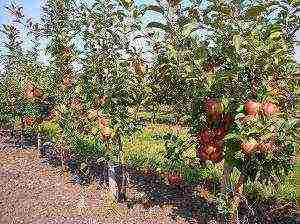 Dwarf apple trees are considered, the height of which does not exceed 2.5, and the root system has a fibrous structure, which is located in a meter layer of soil.
Dwarf apple trees are considered, the height of which does not exceed 2.5, and the root system has a fibrous structure, which is located in a meter layer of soil.
This fact is used by gardeners, in an area with a close occurrence of groundwater, which can damage the deep-lying roots of trees.
All varieties of dwarf apple trees can be divided into groups, depending on when the fruits fully ripen:
- summer type;
- autumn type;
- winter type.
Dwarf apple varieties
Candy
Very early ripening variety, apples ripen in the first week of August.The apple tree is distinguished by its excellent quality, fragrant round-shaped fruits, covered with a rich green skin and strong crunchy flesh. Average fruit weight 125 g.
Candy perfectly tolerates frost and sudden temperature changes.
Important! If frosts nevertheless damage the aboveground part of the tree, then it tends to recover very soon and resume fruiting.
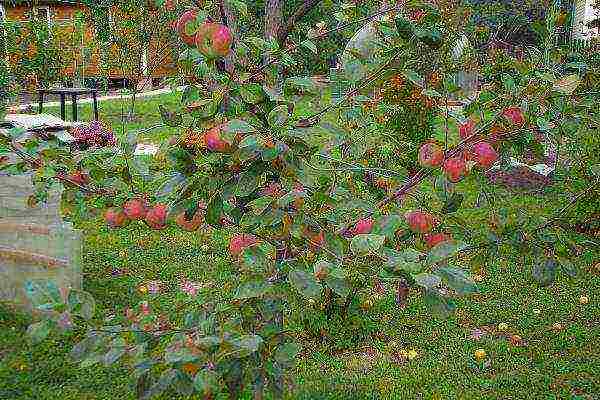
Candy.
Read more about the Candy apple tree in this article.
Melba
It is a popular, widespread variety withThe first among dwarf varietiesrecognized by breeders.
Attracts gardeners with its early maturity (The 1st crop can be removed in the 3rd year after planting), excellent yield (up to 145 - 150 kg of fruits per tree) and unpretentiousnesshowever it is worth noting average resistance to scab pathogens and severe frosts.
Apples ripen in the first half of August, medium-sized fruits (average weight 155 g), rounded in shape, covered with a delicate skin, on which there is a raspberry blush.
Inside, the fruit is snow-white, tender, pleasant in structure, very aromatic.The taste is sweet, with a special caramel aftertaste.

Melba.
You can find out more about the Melba apple tree here.
Moscow necklace
Enough new variety, instantly loved by fruit growers for its large tasty apples, which reach full maturity in October and early maturity: the primary harvest can be seen as early as the 3rd year after the tree is placed on the site. The apple tree is resistant to the scab pathogen, tolerates frost well.
Fruit:
- enlarged, leveled, average weight - 173 g;
- spherical regular shape;
- covered with a loose skin of a wine-red color;
- have an amazing aroma, fragile and juicy structure;
- The taste is sweet and sour, with an unobtrusive sourness.
After harvest can be stored for up to 100 days.

Moscow necklace.
You can read more about the Moscow necklace apple tree here.
Wonderful
The height of a tree of this variety is from 1.6 to 2 m, depending on the type of rootstock, the crown is sweeping, with falling branches dropping even lower under the weight large fruits (average weight 210 g).
Fruits are spherical, slightly flattened in the center, aligned, covered with a thin yellow-green skin. Apple has classic dessert taste, with a barely noticeable sourness, pleasant consistency.
Important! One of the most important advantages of this variety is that the apple tree perfectly tolerates stagnant water.
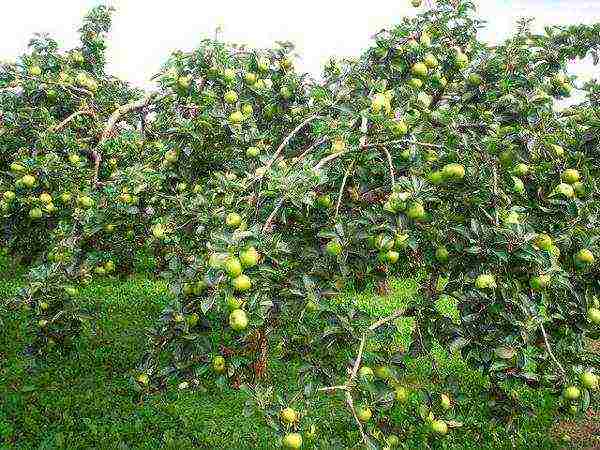
Wonderful.
You will learn more about the Chudnoye variety from this article.
Sokolovskoe
Belongs to the category natural dwarfs, its height is 1.1 - 2 m, fruiting irregular, begins in the 4th year after planting. Productivity 55 -65 kg per tree.
Fruits are flattened-spherical, covered with a delicate but dense glossy dry skin of a yellowish hue, which by the time of ripening is covered with large raspberry strokes. Under the skin the apple is granular, dense, creamy, aromatic, with a sweet and sour taste.
Average winter hardiness, too cold temperatures in winter can damage the fruit buds. Prolonged drought in summer negatively affects the taste characteristics of apples.
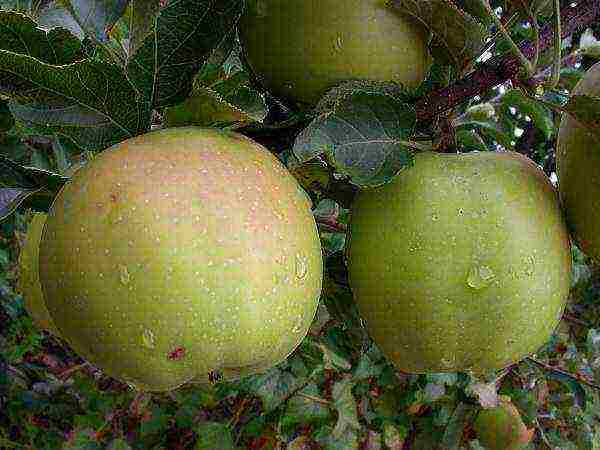
Sokolovskoe.
Read more about the Sokolovskoye apple in this article.
Zhigulevskoe
Stunted tree, very quickly entering the fruiting period, the fruits are ready for harvest in September, have a round shape. Covered from above with a dense thin skin of a yellow-green hue, by the time of full ripeness it is covered with crimson vertical streaks.
Excellent taste characteristics, the yield tends to increase from year to year.
The variety is resistant to pathogens of fungal diseases and the influence of pests, winter hardiness is above average.
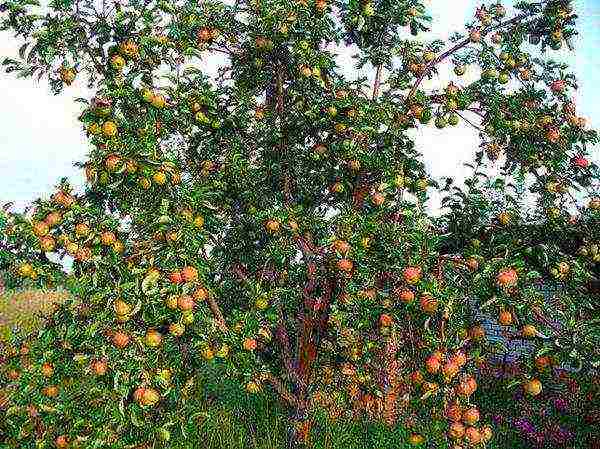
Zhigulevskoe.
You can find out more about the Zhigulevskoye apple tree here.
Snowdrop
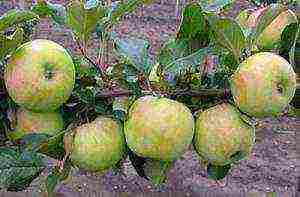 This variety of apples - genetic dwarfs, reaches a height of 1.5 m, refers to slate... Very fast, the first harvest can be removed 3 years after planting.
This variety of apples - genetic dwarfs, reaches a height of 1.5 m, refers to slate... Very fast, the first harvest can be removed 3 years after planting.
The yield is high, but over time, an implicit periodicity may appear.
High drought tolerance and frost tolerance, the apple tree is able to withstand low temperatures down to -40 ° C.
Fruit:
- medium by weight, which varies from 135 g to 173 g;
- rounded-elongated shape;
- the top of the apples is covered with a thin peel, dry and smooth, of a pale yellow hue with raspberry-pink strokes along the perimeter of the fruit;
- apple pulp is juicy and crunchy, sweet and sour, aromatic.
The fruits are ready to be harvested in early September, universal in appointment, can be stored for up to four months.

Snowdrop.
You can read more about the Snowdrop apple tree here.
Carpet
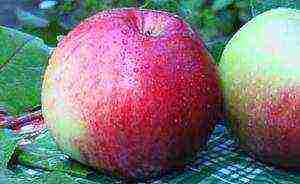 Autumn stunted tree, recommended for cultivation in the Ural and West Siberian regions, possesses tremendous frost resistance and resistance to the influence of pathogens of fungal diseases.
Autumn stunted tree, recommended for cultivation in the Ural and West Siberian regions, possesses tremendous frost resistance and resistance to the influence of pathogens of fungal diseases.
Carpet is distinguished by its early maturity, the first harvest should be expected after 3-4 years after grafting, the yield is high (64 kg per tree), but over time periodicity can be observed.
The fruits are enlarged, the average weight is 155 - 160 g, have a spherical, slightly flattened shape, covered with a soft, delicate skin of a yellow-light green color, with a bright scarlet blush.
The inside is dryish, with active grain, beige.
The purpose of the crop is processing and fresh consumption.
Apples can be stored in a cool place for up to one and a half months.
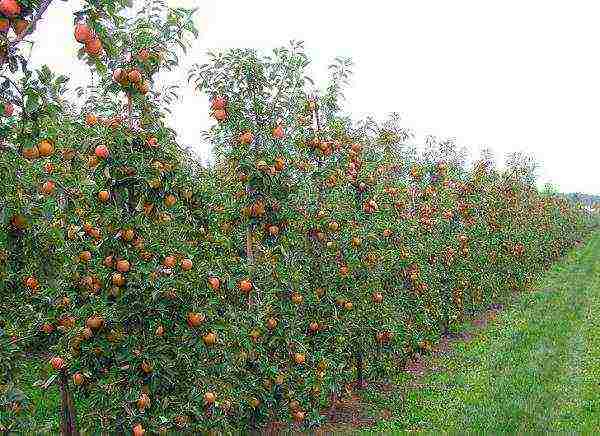
Carpet.
You will learn more about the Carpet variety from this article.
Bratchud
The apple-tree of the Chelyabinsk selection belongs to the natural elite. The apple tree is medium-late (collection - mid-September), the fruits are medium (145 - 165 g), round, slightly elongated with an implicit ribbing. The peel is smooth, glossy, dry, olive green in color with an unobtrusive blush.
Inside apple with an active white shade, medium-grained, not juicy, sour-sweet taste with a pleasant aroma. Fruits can be stored for up to 4 months, transportability is satisfactory.
Variety stands out for its resistance to frost. Among the shortcomings, it is worth highlighting the weak resistance to scab pathogens.

Bratchud.
Read more about the Bratchud apple tree in this article.
Grounded
Large-fruited early ripening variety, characterized by an excellent yield (up to 135 kg per apple tree), the first harvest can be obtained three years after planting the tree in the ground.
Fruits are large, average weight 145 g, spherical shape. The apple is covered with a dense thin fragrant green peel, by the time of ripeness it becomes covered with a beautiful even blush, the taste is sweet and sour, which has received a high tasting rating.
Important! This variety has excellent scab resistance and high frost resistance.
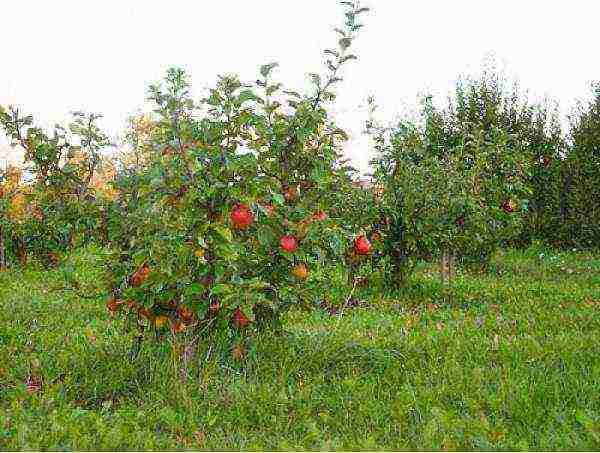
Grounded.
You can find out more about the landed apple here.
Legend
This the variety of undersized baby apple trees is early winter (collection can be carried out from the beginning of October), enters the fruiting phase in the 3rd year after planting in the garden.
Fruits are slightly ribbed, round, somewhat elongated, the main color of a strong thin skin is light green-yellow, the integumentary color is bright crimson with thick burgundy vertical stripes. Inner part juicy, white with creamy splashes, with a distinct apple smell and dessert taste. Fruit weight can vary from 175 g to 200 g.
After harvest can be saved for 90 days.

Legend.
You can read more about the Legend apple tree here.
Moscow red
Variety with excellent yield, late fruiting (the crop is harvested in the first decade of October), it is highly resistant to scab pathogens and other diseases, winter hardiness and frost resistance are satisfactory.
The fruits are smooth, round, the peel is strong, but thin, green in color; by the time of ripening, a crimson continuous blush appears on the side. The weight of apples is 135 - 185 g.
After ripening and picking apples can be stored for up to 120 days.

Moscow red.
Stunted
The variety is recommended for cultivation in the Central Black Earth zone, fast-growing, frost-resistant.
Important! A significant disadvantage is that the Stunted in a rainy summer can be infected
scab
.
The fruits of this apple tree are round, slightly flattened in the center, medium-sized, covered with a smooth glossy skin of a yellow-green hue. By the time the hearth is removed, it is covered with wide crimson stripes almost along the entire perimeter of the apple.
The flesh is crunchy, dense, sourish and very juicy with a white-green hue with a classic apple scent.

Stunted.
Read more about the Low-growing apple tree in this article.
Sun
This variety is late autumn (harvested towards the end of September), distinguished by immunity to scab pathogens, excellent frost resistance and quite satisfactory yield.
Fruits are medium-sized in size (145 g), elliptically oblique, aligned, covered with a strong oily skin of a green-yellow color, which by the time of maturity is covered with a bright continuous scarlet blush.
The taste is unobtrusive, sweet and sour with a pleasant fresh fruity aftertaste.Inside, the apple is dense, homogeneous, juicy, snow-white, with a pleasant aroma.

Sun.
You can find out more about the Sun apple tree here.
Arbat
This variety not only dwarf, but also columnar, it is distinguished by a quick entry into fruiting (the first crop can be harvested for 2 - 3 years after placing in the garden), disease and pest resistance and excellent frost resistance, which makes it possible to cultivate it in the northern regions.
Fruits are medium-sized, elliptical, covered with a strong shiny skin of a rich red-pink hue. Inside, the fruit is fragrant, creamy, juicy and sweet, with a slight sourness.
Once harvested, they can be stored for up to several months, but may lose taste over time.
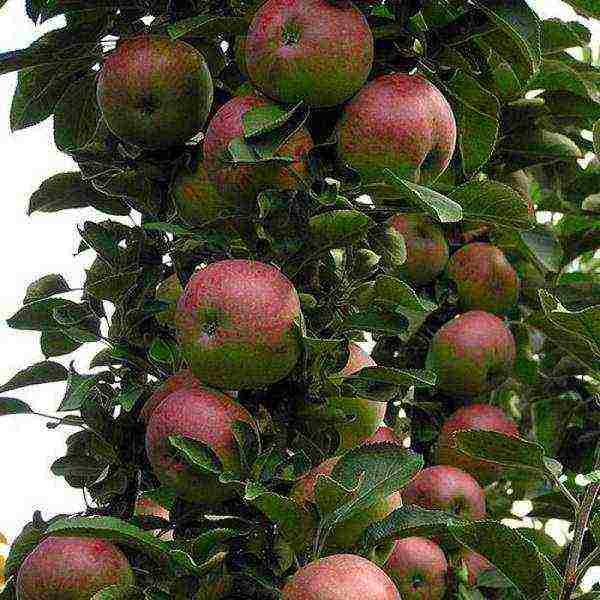
Arbat.
You can read more about the Arbat apple tree here.
For the middle lane
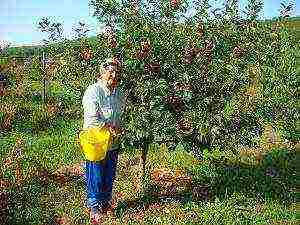 In order to choose the right variety of apple trees for cultivation in a certain region, you need to understand what requirements they must meet.
In order to choose the right variety of apple trees for cultivation in a certain region, you need to understand what requirements they must meet.
So, the middle strip of our country is characterized by frequent return frosts in spring, possible frosts in early autumn, as well as slushy warm winters, in which the root system of a number of horticultural crops may be soaked.
Such weather conditions can be abruptly replaced by frost, which is the main problem.
Low-growing varieties for the middle lane:
- Melba;
- Candy;
- Zhigulevskoe;
- Autumn striped;
- Grushovka Moscow;
- Bogatyr;
- Arbat;
- Moscow necklace;
- Bratchud;
- Legend.
Useful photos and videos

Grushovka Moscow.
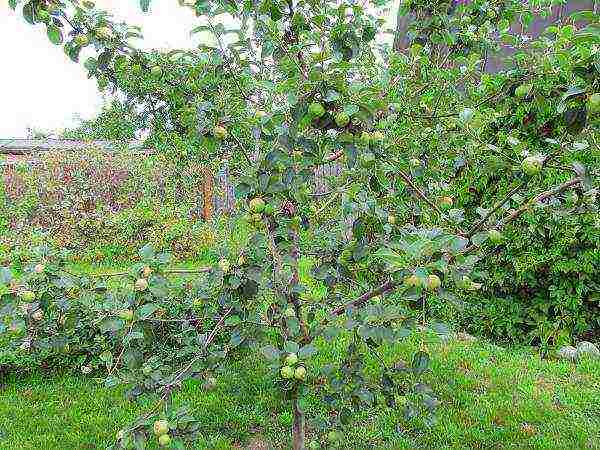
Bogatyr.
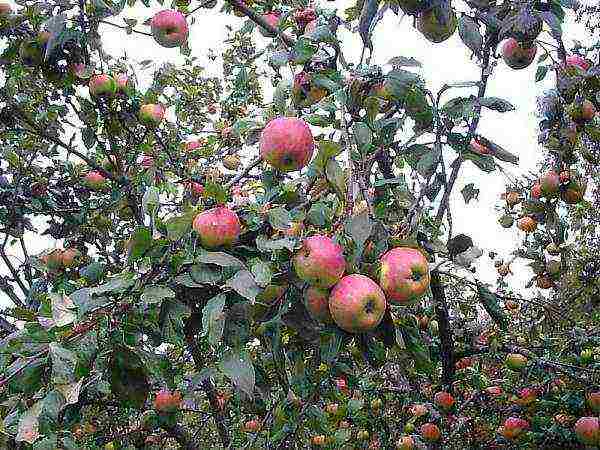
Autumn striped.
Watch a video describing the varieties listed above:
Watch a video about dwarf apple trees:
Watch a video about Sokolovskoe and Kovrovoye varieties:
Watch a video about Yablona Arbat:
Conclusion
Understanding what is necessary for the successful cultivation of dwarf apple trees, you can easily choose the perfect variety, draw up an agrotechnical plan for him, choose the best place in the garden.
Among the great many works of breeders to date even the most picky gardener will find the apple tree of his dreams!

